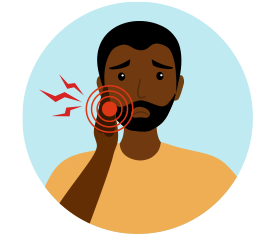Assess your gum disease risk level - Delta Dental Insurance
Are you at risk for gum disease?
-
The leading cause of tooth loss for people in the U.S. isn’t old age. It’s gum disease (also known as periodontal disease). Nearly half of adults ages 30 and older have gum disease, according to the Centers for Disease Control and Prevention.
To find out if you’re at risk, take this five-minute quiz. Answer the questions and total your score to find your results.
-

-

Question 1:
Are you over 65 years old?
Yes: +5
No: 0
-

Question 2:
How often do you brush your teeth?
Less than once a day: +2
Once a day: +1
Two or more times a day: 0
-

Question 3:
How often do you clean between your teeth with dental floss or an interproximal brush?
Less than three times a week: +2
3-4 times a week: +1
Daily: 0
-

Question 4:
Do your gums ever bleed when you brush or floss your teeth?
Yes: +2
No: 0
-

Question 5:
How often do you have your teeth professionally cleaned by a dentist or dental hygienist?
Less than once a year: +2
Once a year: +1
Twice or more a year: 0
-

Question 6:
Do any of your teeth feel loose?
Yes: +4
No: 0
-

Question 7:
When you look in the mirror, do you see more of a tooth than you used to, i.e., is more of a tooth exposed due to the gum being lower than it used to be?
Yes: +4
No: 0
-

Question 8:
Has your dentist or dental hygienist ever told you that you have gum disease, gingivitis or gum infection?
Yes: +5
No: 0
-

Question 9:
Have you ever had a tooth removed because of gum disease?
Yes: +6
No: 0
-

Question 10:
Does anyone in your immediate family (parents, siblings) have a history of gum disease?
Yes: +2
No: 0
-

Question 11:
Do you smoke or use any other tobacco products?
Yes: +4
No: 0
-

Question 12:
Do you have diabetes?
Yes: +2
No: 0
-

Question 13:
If you have diabetes, is it well controlled?
Yes: 0
No: +4
I don't have diabetes: 0
-

Question 14:
Have you been diagnosed with heart disease, stroke, high blood pressure or osteoporosis?
Yes: +1
No: 0
-

Question 15:
Are you pregnant?
Yes: +1
No: 0
-
Total up your points and use the guide to find your risk level.
If your score is ...
- Below 0 and 3, your risk level is low
- Between 4 and 8, your risk level is medium
- 9 points or higher, your risk level is high
Read on to learn more about your score and what you can do to protect yourself from gum disease.
Keep up the healthy habits! Visit your dentist regularly (every six to 12 months) for an exam and continue brushing and flossing daily to maintain your healthy smile.
You are at medium risk for gum disease. Make an appointment to see your dentist within the next six months. Here are some more tips for fighting gum disease and lowering your risk level:
Brush and floss
To help prevent gum disease, you should:
- Brush at least twice a day for at least two to three minutes with fluoride toothpaste.
- Floss at least once daily.
Be sure you’re using proper brushing technique with the head of your toothbrush placed at a 45-degree angle to the gum line. Using a motorized toothbrush can give a boost to your brushing ability and plaque removal.
You should clean between all of the teeth on a daily basis using floss. It might seem easier to only floss the teeth that you can reach, or where food is trapped, but that will leave harmful plaque in your mouth, so be sure to floss all your teeth. Although flossing a few times a week is better than not at all, you need daily flossing to remove the bacteria from in between your teeth.
Visit your dentist
Routine dental visits are necessary so that plaque buildup can be professionally removed before it becomes a problem. Your dentist will also be able to give you professional treatment for gum disease before it gets worse.
Visit your dentist as soon as possible. Here are some tips for fighting gum disease and lowering your risk level.
Brush and floss
To help prevent gum disease, you should:
- Brush at least twice a day for at least two to three minutes with fluoride toothpaste.
- Floss at least once daily.
Plaque is a soft, sticky film that builds up on teeth and contains millions of bacteria. The bacteria in plaque cause tooth decay and gum disease if they are not removed daily through brushing and flossing.
In addition to brushing twice daily, be sure you’re using proper brushing technique with the head of your toothbrush placed at a 45-degree angle to the gum line. Using a motorized toothbrush can give a boost to your brushing ability and plaque removal.
You should clean between all of the teeth on a daily basis using floss. Many people only floss the teeth that they can reach, or where food is trapped. Although flossing a few times a week is better than not at all, it's still not enough to remove all the bacteria from in between the teeth.
Calculus, or tartar, is caused by inadequate removal of plaque. Plaque that is not removed can become mineralized and harden into calculus. Although brushing and flossing can remove plaque, once calculus is formed, it is too hard and firmly attached to be removed with a toothbrush.
Visit your dentist
Keep up with routine dental visits so that plaque buildup can be professionally removed before it becomes a problem. Your dentist will also be able to give you professional treatment for gum disease before it gets worse.
How to watch for gum disease
No matter your score, you should be familiar with the warning signs and risk factors:
Bleeding gums
Healthy gums don’t typically bleed. Bleeding gums are a common indication of gum disease.
Gingivitis is the early stage of gum disease, which can be treated and reversed if diagnosed early. The signs and symptoms are red, swollen and puffy gums that bleed easily.
Think of gum tissue as the skin on your hand. If your hands bled every time you washed them, you’d know something was wrong. Bleeding gums should be evaluated by your dentist.
Receding gums
An area of gum recession is an area that has lost its underlying bone support and, as a result, the gums begin to pull away from the teeth, causing the teeth to look longer than before. It’s important that this area be evaluated by a dentist.
The following signs and symptoms may indicate gum recession:
- Your teeth are sensitive.
- Your teeth may appear longer than normal. A larger part of the crown (body of the tooth) is visible when your gums recede.
- Teeth look notched at the gum line.
- Your tooth’s color seems changed due to the color difference between enamel and cementum. Cementum is a bone-like connective tissue covering the surface of the tooth root that assists in tooth support.
- The spaces between your teeth seem to grow. Usually, the distance between your teeth hasn’t actually changed, but it seems larger because the gums aren’t filling the gaps any more.
- Cavities develop below the gum line.
- Your gums are puffy, red or swollen (inflamed).
Loose teeth
Gum disease leads to destruction of the attachment fibers and supporting bone that hold your teeth in place. If neglected and allowed to progress, teeth can become loose and require extraction or fall out.
If any of your teeth feel loose, you should make an appointment with your dentist as soon as possible.
Age
Nearly half of people 30 years and older have gum disease. Your risk increases as you get older. More than 70% of adults 65 years and older have some form of gum disease.
Gum disease is not an inevitable part of aging. It’s related to other risk factors that are prevalent in older adults such as:
- Diminished general health
- Diminished immune system
- Medication side effects
- Depression
- Memory decline
- Reduced salivary flow
- Functional impairments (such as arthritis)
- Change in financial status
With the proper preventive care, such as brushing twice daily, flossing daily, and regular dental visits, you can expect to retain gum health well into your later years.
Gum disease in your past
If you’ve been diagnosed or treated for gum disease in the past, you’re at greater risk for gum disease in the future. Regular follow-up care is essential for maintaining good dental health and identifying and treating any recurrence.
If you have a history of gum disease, you may be six times likelier to have a reoccurrence. If you’ve had a tooth removed because of gum disease, you’re at a higher risk of needing to have a tooth removed in the future.
Periodontal disease can also run in the family — and not just genetically.
The bacteria that cause gum disease may be passed from parents to children and between couples when kissing or sharing eating utensils. Up to 30% of the population may be genetically susceptible to gum disease. Genetically susceptible individuals may be up to six times likelier to develop the condition.
Diabetes
Research has shown that people with diabetes have a higher risk of developing infections, including gum disease. People with diabetes are approximately three times likelier to develop gum disease.
People with gum disease may also find their diabetes harder to control, as gum disease can impair the ability to process and utilize insulin. And, in turn, poorly controlled diabetes increases the risk of diabetic complications, including gum disease.
Heart disease
If you have cardiovascular disease, you may have an increased risk of gum disease.
Alternately, if you have gum disease, you may be at an increased risk for cardiovascular disease.
Osteoporosis
Osteoporosis in combination with gum disease may lead to an increased risk of tooth loss due to the decreased density of the bone that supports the teeth.
Pregnancy
Due to hormonal changes, a woman may be more susceptible to gum disease during pregnancy. Pregnancy may also lead to an increase in the severity of pre-existing gum disease.
There may be an increased risk of pre-term, low-birth-weight babies in pregnant women who have active gum disease during their pregnancy.
You should schedule a checkup in your first trimester for a cleaning. If your pregnancy is more advanced, call your dentist for the first available appointment. Your dentist will assess your oral health and map out a dental plan for the rest of your pregnancy.
Smoking
Studies have shown that tobacco use may be one of the highest risk factors in developing gum disease. Use of tobacco products can make you three to four times likelier to develop advanced periodontal disease and can decrease your response to treatment. People who use tobacco products and are genetically susceptible to gum disease are seven to eight times likelier to develop advanced periodontal disease.
If you smoke, stop. Your dentist or dental hygienist can help or direct you to resources to help you quit smoking.
-
Want to brush up on your dental knowledge?
Check out our wellness library to find preventive care tips, articles and more.
-
The oral health information on this website is intended for educational purposes only. Always consult a licensed dentist or other qualified health care professional for any questions concerning your oral health.
